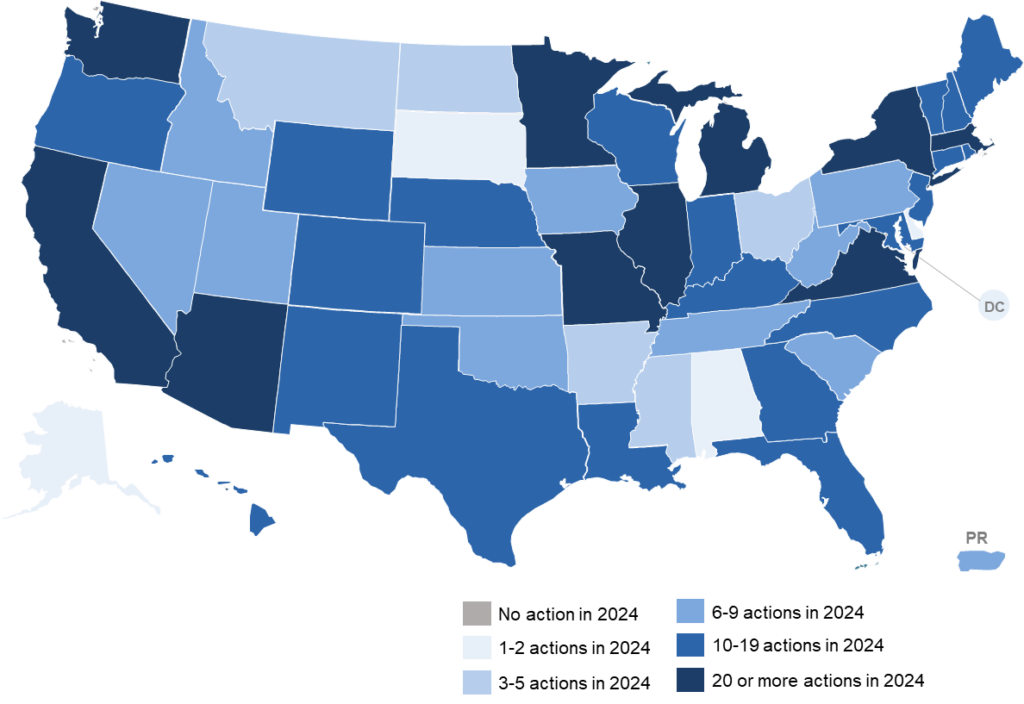50 States of Power Decarbonization 2024: Rapid Load Growth Becomes Focus of Resource Planning in 2024
Raleigh, NC – (February 20, 2025) The N.C. Clean Energy Technology Center (NCCETC) released its 2024 annual review and Q4 2024 edition of the 50 States of Power Decarbonization. The quarterly series provides updates on state and utility actions pertaining to clean energy targets, emission reduction targets and carbon policies, generation planning and procurement rules, integrated resource plans, and electric generation capacity changes (RFPs, green tariffs, power plant retirements, etc.).
The 2024 annual review report finds that all 50 states, as well as DC and Puerto Rico, took a total of 707 actions related to electric power decarbonization and resource planning during the year (see figure below). The report notes the top ten states taking the greatest number or most impactful actions in 2024 were Vermont, Virginia, Massachusetts, Washington, California, Rhode Island, Nevada, Colorado, Maine, and Michigan.
2024 Action on Power Decarbonization and Resource Planning

The report highlights ten of the top power decarbonization and resource planning trends of 2024:
- Solar leading planned capacity additions, while gas additions climbed;
- Utilities tackling load growth in integrated resource plans;
- States studying policy options to support advanced nuclear;
- Legislators imposing stricter requirements for power plant retirements;
- Utilities developing tariffs for data center customers;
- Atlantic states pursuing offshore wind procurements;
- Utilities proposing hydrogen blending for new natural gas generation;
- States encouraging battery storage procurement;
- States upholding and expanding carbon pricing mechanisms; and
- States and utilities adopting policies and plans promoting new nuclear development.
“Load growth was the biggest topic of the year, with utilities focusing on this in their IRPs and states considering rules and tariffs for serving new large load customers, like data centers,” noted David Sarkisian, Principal Policy Analyst at NCCETC.
Among integrated resource plans recently filed or under review by regulators in 2024, planned capacity additions totaled 139,916 MW for solar, 82,826 MW for wind, 77,725 for natural gas, and 63,418 for storage, while planned coal retirements totaled 54,317 MW.
2024 Utility Integrated Resource Planning Action, by Largest Planned Resource Addition
“For the second year in a row, solar was by far the resource with the most planned capacity additions in utility IRPs,” observed Rebekah de la Mora, Senior Policy Analyst at NCCETC. “However, we saw a significant uptick in plans to add natural gas capacity – increasing by 44% over what was included in IRPs under consideration last year.”
In Q4 2024, 46 states, DC, and Puerto Rico took some type of action on power decarbonization and resource planning. A total of 367 actions were tracked in Q4.
ABOUT THE NC CLEAN ENERGY TECHNOLOGY CENTER
The NC Clean Energy Technology Center, as part of the College of Engineering at North Carolina State University, advances a sustainable energy economy by educating, demonstrating and providing support for clean energy technologies, practices and policies. It serves as a resource for innovative, sustainable energy technologies through technology demonstration, technical assistance, outreach and training. For more information about the Center, visit: http://www.nccleantech.
Media Contact: Shannon Helm, NCCETC, shannon_helm@ncsu.edu